Care tips and advice
These houseplants are happy when they have access to water in the soil or air. Find out more about the ideal growing conditions and care tips to make sure your plant has a long and happy life.
Bird’s nest fern
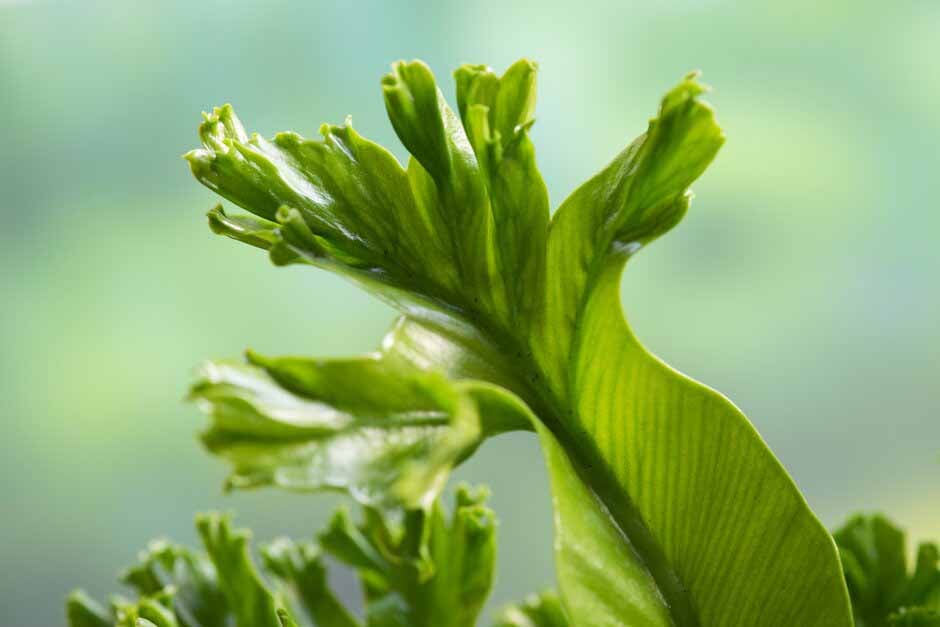
Asplenium antiquum
Light: Bird’s nest fern prefers bright, indirect light. Direct sunlight can burn its leaves, while too little light can stunt growth. A north-facing window or a spot receiving filtered light from a south or east-facing window is ideal.
Watering: Keep the compost consistently moist but not waterlogged. Water when the few centimetres of compost feels dry to the touch.
Asplenium antiquum does not like to dry out completely. Use lukewarm water to avoid shocking the plant.
Humidity: High humidity is crucial for the bird’s nest fern. Aim for 60 per cent humidity or higher. Use a humidifier, mist the plant regularly, or place the pot on a pebble tray with water to increase ambient humidity. Avoid getting water directly in the center of the plant as this can cause rot.
Temperature: Ideal temperatures range between 18°C and 27°C. The bird’s nest fern is sensitive to cold and should be protected from drafts and sudden temperature drops.
Fertiliser: Feed every during the growing season (April to September) following the instructions on the pack. Reduce feeding in autumn and winter as the plant growth slows.
Pruning: Pruning is generally not required except to remove any brown or yellow leaves. Always cut the affected fronds at the base near the soil to keep the plant looking tidy.
Repotting: Repot every 2-3 years or when the plant outgrows its pot. Use a well-draining potting mix that’s rich in organic matter. Spring is the best time for repotting.
Pests and Diseases: Bird’s nest fern is relatively disease-resistant but can be susceptible to scale insects and mealybug.
Stromanthe tricolor
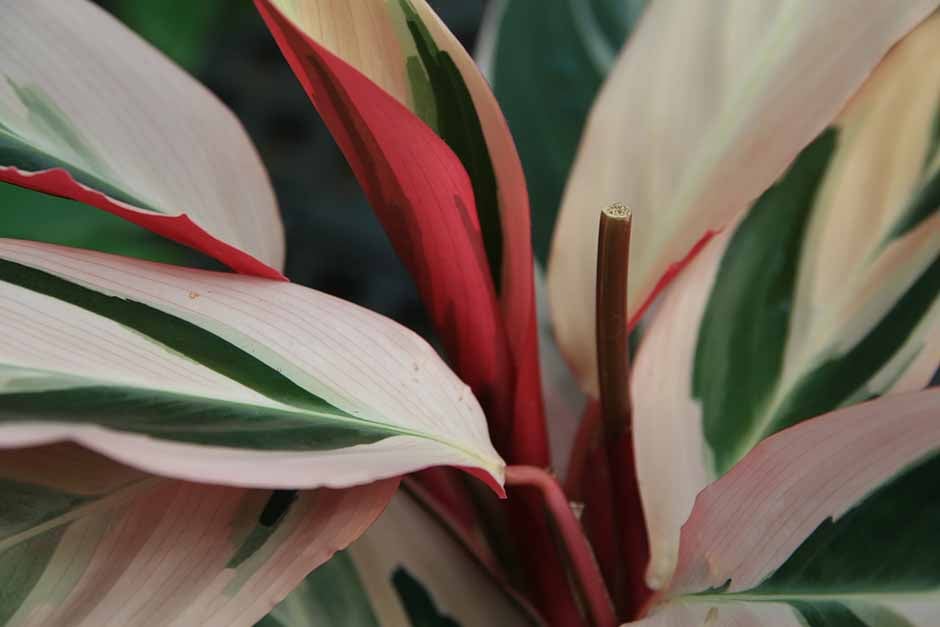
Stromanthe sanguinea ‘Triostar’
Light: Stromanthe sanguinea ‘Triostar’ prefers bright, indirect light. It can tolerate lower light conditions, but its colours will be more vibrant with adequate light. Avoid direct sunlight, which can scorch its delicate leaves. A spot near an east or north-facing window is ideal.
Watering: Keep the compost consistently moist but not soggy. Water when the few centimetres of compost feels dry to the touch.
Stromanthe Triostar is sensitive to fluoride and other chemicals commonly found in tap water, so it’s best to use filtered, distilled, or rainwater to avoid leaf tip burn. Overwatering can lead to root rot, so ensure the compost is well-draining.
Humidity: High humidity is crucial for maintaining the health and vibrancy of the
Stromanthe sanguinea ‘Triostar’. Aim for 60 per cent humidity or higher. Use a humidifier, mist the plant regularly, or place the pot on a pebble tray with water to increase ambient humidity. Avoid getting water on the leaves when misting, as this can lead to spots.
Temperature: Ideal temperatures range between 18°C and 27°C. Protect the plant from drafts and sudden temperature changes, which can stress it.
Fertiliser: Feed every during the growing season (April to September) following the instructions on the pack. Reduce feeding in autumn and winter as the plant growth slows.
Pruning: Pruning is not typically necessary except to remove any brown or damaged leaves. Use clean, sharp scissors and cut the leaves at the base to maintain a tidy appearance.
Repotting: Repot in the spring every 2-3 years or when the plant becomes root-bound. Use a well-draining, peat-free houseplant compost and a pot with good drainage holes. Choose a pot only slightly larger than the current one to prevent overwatering.
Pests and Diseases: Be vigilant for pests such as spider mites, mealybug and aphids.
Variegated Swiss cheese plant
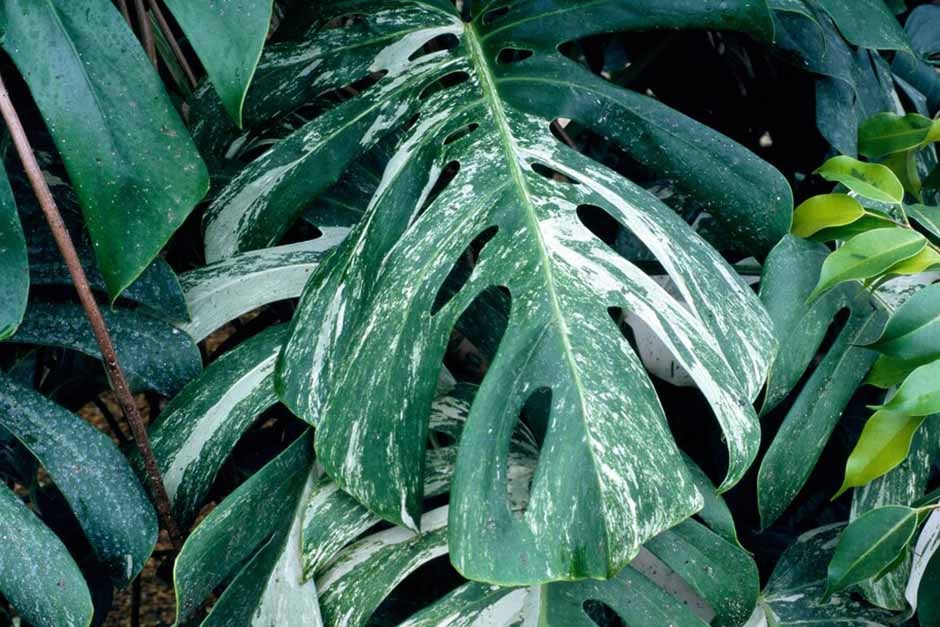 Monstera deliciosa ‘Variegata’
Light:
Monstera deliciosa ‘Variegata’
Light: Variegated monstera prefers bright, indirect light. Direct sunlight can scorch its leaves, especially the white or light-coloured variegated areas that are more susceptible to sunburn. A spot that receives filtered sunlight, such as near an east-facing window with sheer curtains, is ideal.
Watering: Water when the top few centimetres of compost feel dry to the touch. Monsteras are slightly more sensitive to overwatering than their non-variegated counterparts, as the variegated parts of the leaves cannot photosynthesise as efficiently. Ensure good drainage to prevent root rot.
Humidity: This plant thrives in high humidity environments, ideally between 60and 80 per cent. If your indoor air is dry, use a humidifier, mist the plant regularly, or place the pot on a pebble tray filled with water to increase humidity around the plant.
Temperature: Maintain temperatures between 18°C and 27°C. Protect your monstera from drafts and extreme temperature changes, which can stress the plant.
Fertiliser: Feed every during the growing season (April to September) following the instructions on the pack. Reduce feeding in autumn and winter as the plant growth slows.
Pruning: Pruning is not typically necessary for health but can be done to shape the plant or remove any yellow or damaged leaves. Always use clean, sharp scissors or pruning shears to make cuts.
Repotting: Repot every 2-3 years or when the plant becomes root-bound. Spring or early summer is the best time for repotting. Use a well-draining potting mix and a pot that is one size larger than the current one.
Pests and Diseases: Keep an eye out for pests such as mealybug and scale insects.
Beware: this plant is harmful if eaten and a skin and eye irritant for humans and pets.
Black-gold Philodendron

Philodendron melanochrysum
Light: Philodendron melanochrysum prefers bright, indirect light. Too much direct sunlight can scorch its leaves, while too little light can result in less vibrant foliage. A spot near an east or west-facing window with filtered light is ideal.
Watering: Water when the top 2-3 inches of compost become dry to the touch. This plant likes consistent moisture but does not like to be waterlogged. Ensure good drainage to avoid root rot.
Humidity: High humidity levels, ideally between 60 to 80 per cent, are crucial for the
Philodendron melanochrysum. Use a humidifier, mist the plant regularly, or place the pot on a pebble tray with water to increase humidity.
Temperature: Maintain temperatures between 18°C to 27°C. Avoid exposure to temperatures below 15°C, as cold can damage the plant. Keep it away from drafts and sudden temperature fluctuations.
Fertiliser: Feed every during the growing season (April to September) following the instructions on the pack. Reduce feeding in autumn and winter as the plant growth slows.
Pruning: Pruning is not typically necessary for health but can be done to shape the plant or remove any yellow or damaged leaves. Use clean, sharp scissors or pruning shears, cutting just above a leaf node to encourage fuller growth.
Repotting: Repot every 2-3 years or when the plant becomes root-bound. Use a well-draining potting mix rich in organic matter. The best time to repot is in the spring.
Pests and Diseases: Be on the lookout for pests such as aphids, red spider mite and mealybug.
Beware: this plant is harmful if eaten and a skin and eye irritant for humans and pets.
Crystal anthurium
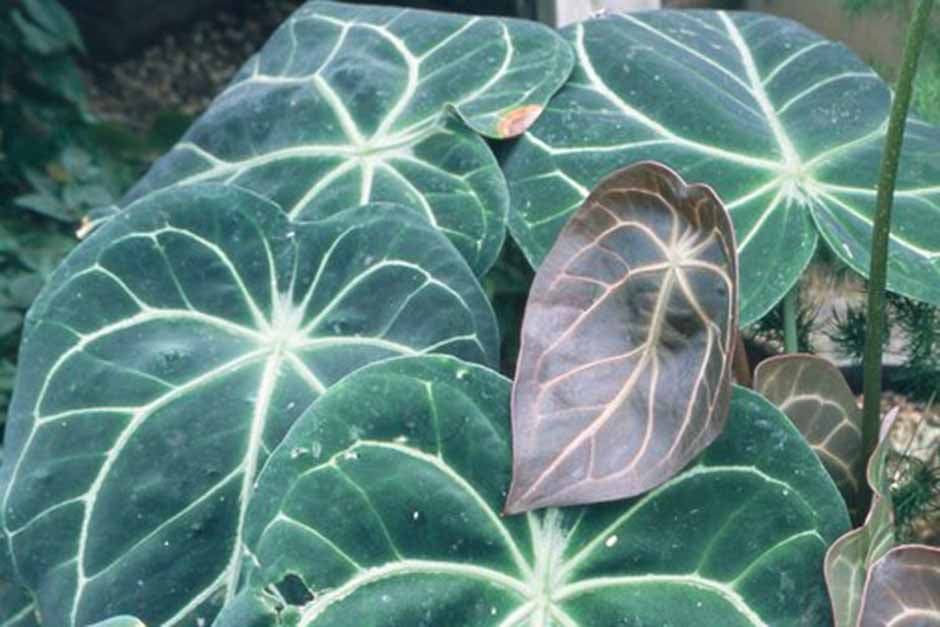
Anthurium crystallinum
Light: Anthurium crystallinum prefers bright, indirect light. Direct sunlight can scorch its leaves, while too low light can cause leggy growth and less vibrant foliage. A location near an east or west-facing window, with sunlight filtered through curtains, is ideal.
Watering: Water when the top few centimetres of compost feels dry to the touch. This plant prefers consistently moist compost but does not like to be waterlogged. Ensure good drainage to avoid root rot. Use lukewarm, filtered water to minimize the risk of leaf burn from tap water chemicals.
Humidity: High humidity, around 70 per cent or higher, is crucial for
Anthurium crystallinum. Use a humidifier, mist the plant regularly, or place the pot on a tray filled with pebbles and water to increase the surrounding humidity. Avoid wetting the leaves directly to prevent fungal diseases.
Temperature: Ideal temperatures range between 18°C to 27°C. Protect the plant from drafts and sudden temperature changes, as it is sensitive to cold.
Fertiliser: Feed every during the growing season (April to September) following the instructions on the pack. Reduce feeding in autumn and winter as the plant growth slows.
Pruning: Pruning is generally not necessary for health but can be done to remove yellow or damaged leaves to keep the plant looking tidy. Use clean, sharp scissors or pruning shears for any cuts.
Repotting: Repot every 2-3 years or when the plant becomes root-bound. Use a well-draining, airy potting mix, ideally one that includes chunky components like pumice, and pine bark. Spring is the best time to repot, allowing the plant to recover and grow into its new pot during the growing season.
Pests and Diseases: Keep an eye out for pests such as aphids, red spider mite, mealybug and scale insects.
Beware: this plant is harmful if eaten and a skin and eye irritant for humans and pets.
Mottled Arrowhead plant
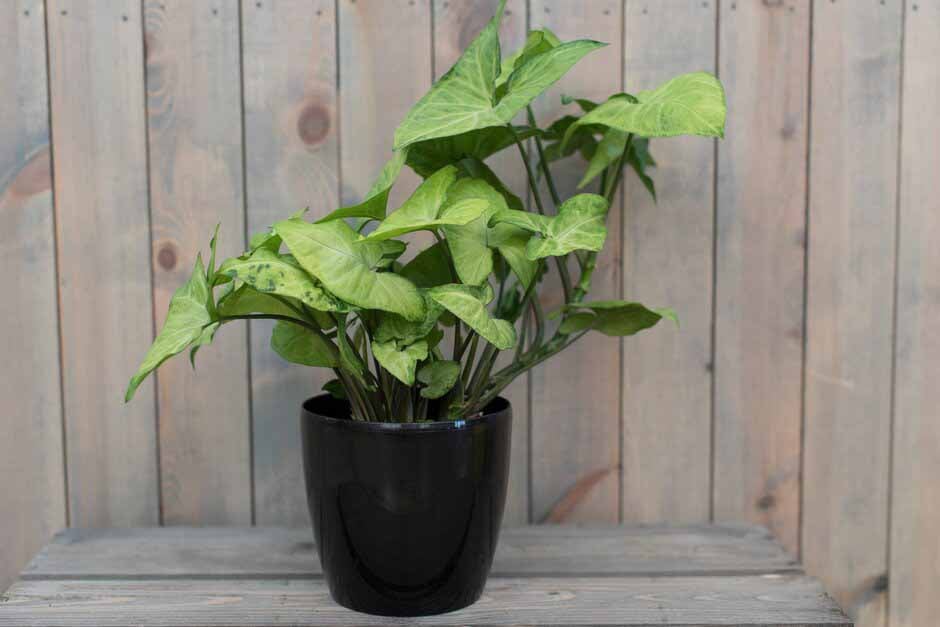
Syngonium podophyllum ‘Mottled’
Light: Syngonium prefers bright, indirect light but can tolerate lower light conditions. Its variegation or colour intensity can be affected by light levels; lower light may lead to less vibrant leaf colours. Avoid direct sunlight, which can scorch the leaves.
Watering: Water when the top few centimetres of compost becomes dry. Syngonium likes evenly moist compost but is somewhat drought tolerant. Overwatering can lead to root rot, so ensure the pot has good drainage.
Humidity: This plant enjoys a humid environment but can adapt to average household humidity. For higher humidity, mist the leaves regularly, use a humidifier, or place the pot on a pebble tray filled with water.
Temperature: Keep the plant in temperatures between 18°C and 27°C. Syngonium is not frost-tolerant and should be protected from cold drafts and sudden temperature drops.
Fertiliser: Feed every during the growing season (April to September) following the instructions on the pack. Reduce feeding in autumn and winter as the plant growth slows.
Pruning: Pruning can help maintain the desired shape and fullness. Regularly pinching off the tips of new growth can encourage bushier growth. Use clean, sharp scissors or pruning shears.
Repotting: Repot in the spring every 2-3 years or when the plant becomes root-bound. Use a well-draining potting mix and a pot with good drainage holes.
Pests and Diseases: Watch out for common pests such as red spider mite, aphids and mealybug.
Kentia palm
 Howea forsteriana
Light:
Howea forsteriana
Light: Kentia palm prefers bright, indirect light but can tolerate lower light conditions better than many other palms. Avoid direct sunlight, which can scorch its leaves. A spot near a window with filtered light is ideal.
Watering: Water when the top few centimetres of compost becomes dry to the touch. Kentia palms prefer evenly moist compost but are sensitive to overwatering. Ensure the pot has good drainage to prevent root rot. Reduce watering in the winter months.
Humidity: While it can adapt to average household humidity, the Kentia Palm benefits from higher humidity levels. If the air in your home is dry, especially during winter, use a humidifier or place the pot on a tray filled with pebbles and water to increase humidity around the plant.
Temperature: Maintain temperatures between 16°C and 27°C for optimal growth. The kentia palm is sensitive to cold and should be protected from drafts and sudden temperature drops.
Fertiliser: Feed every during the growing season (April to September) following the instructions on the pack. Reduce feeding in autumn and winter as the plant growth slows.
Pruning: Pruning is not typically necessary except to remove any yellow or brown fronds. Use clean, sharp scissors or pruning shears, cutting as close to the stem as possible without damaging it.
Repotting: Repot every 2-3 years or when the plant becomes root-bound. Use a well-draining potting mix and a pot just one size larger than the current one to prevent overwatering. The best time to repot is in the spring.
Pests and Diseases: The kentia palm is relatively resistant kentia to pests but can be affected by spider mites, scale, and mealybugs in dry conditions.
Alocasia ‘Jacklyn’

Alocasia tandurusa
Light: Alocasia ‘Jacklyn’ thrives in bright, indirect light. Avoid direct sunlight, as it can scorch the leaves. Place the plant near a window with filtered light or in a well-lit room.
Watering: Keep the compost consistently moist but not waterlogged. Water when the top few centimetres of compost feels dry to the touch.
Alocasia ‘Jacklyn’ prefers slightly higher humidity, so misting the leaves or using a pebble tray can help.
Alocasia ‘Jacklyn’ is susceptible to root rot if overwatered, so ensure proper drainage.
Humidity: Alocasia ‘Jacklyn’ benefits from high humidity levels, ideally between 60 to 80 per cent. Increase humidity by using a humidifier, grouping plants together, or placing the pot on a tray filled with water and pebbles.
Temperature: Maintain temperatures between 18°C to 27°C. Protect the plant from cold drafts and sudden temperature fluctuations, as it prefers warm and stable conditions.
Fertiliser: Feed every during the growing season (April to September) following the instructions on the pack. Reduce feeding in autumn and winter as the plant growth slows.
Pruning: Prune yellow or damaged leaves as needed to maintain the plant's appearance. Use clean, sharp scissors or pruning shears to make cuts close to the base of the stem.
Repotting: Repot
Alocasia ‘Jacklyn’ every 1-2 years in spring or early summer, or when the plant becomes root-bound. Use a well-draining potting mix and a pot that's only slightly larger than the current one.
Pests and Diseases: Keep an eye out for pests such as red spider mite, aphids and mealybug.
Beware: this plant is toxic if eaten and a skin irritant for humans and pets.
Shingle plant
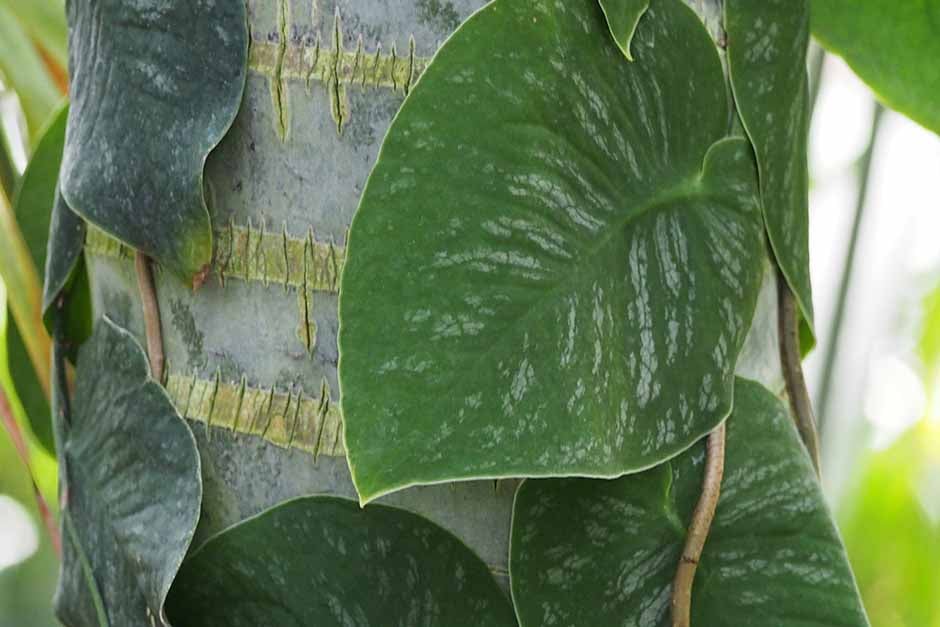
Monstera dubia
Light: Monstera dubia prefers bright, indirect light. Avoid direct sunlight, as it can scorch the leaves. Place the plant near a window with filtered sunlight or in a location with bright, indirect light.
Watering: Keep the compost consistently moist but not waterlogged. Water when the top few centimetres of compost feels dry to the touch. Adjust watering frequency based on environmental conditions, ensuring the compost does not dry out completely.
Humidity: Monstera dubia thrives in high humidity environments. Maintain humidity levels between 60 to 80 per cent. Use a humidifier, mist the leaves regularly, or place the plant on a tray filled with pebbles and water to increase humidity.
Temperature: Maintain temperatures between 18°C to 27°C. Protect the plant from cold drafts and sudden temperature fluctuations, as it prefers warm and stable conditions.
Fertiliser: Feed every during the growing season (April to September) following the instructions on the pack. Reduce feeding in autumn and winter as the plant growth slows
Pruning: Prune yellow or damaged leaves as needed to maintain the plant’s appearance. Use clean, sharp scissors or pruning shears to make cuts close to the base of the stem.
Repotting: Repot
Monstera dubia every 1-2 years in spring or early summer, or when the plant becomes root-bound. Use a well-draining potting mix and a pot that's slightly larger than the current one.
Pests and Diseases: Keep an eye out for pests such as red spider mite, aphids and mealybug.
Beware: this plant is harmful if eaten and a skin irritant for humans and pets.
Sugar Vine

Cissus striata
Light: Cissus striata prefers bright, indirect light but is remarkably adaptable, tolerating lower light conditions well. When grown indoors, place it near a window where it can receive filtered sunlight without direct exposure, which could damage the leaves.
Temperature: This plant enjoys moderate to warm conditions, thriving in temperatures between 15°C to 25°C. It can tolerate cooler nights and slightly warmer days but should be protected from frost and extreme heat, which can stress the plant. Avoid placing it near drafts, air conditioning vents, or heat sources to maintain consistent temperature levels.
Watering: Water your
Cissus striata when the top inch of the soil feels dry to the touch. It prefers evenly moist soil but is drought-tolerant once established. Over-watering or allowing the plant to sit in water can lead to root rot, so ensure the pot has good drainage. During the winter months, reduce watering to prevent waterlogging, as the plant’s water needs decrease.
Humidity: Cissus striata enjoys a bit of humidity but will generally do well in average home environments. If you notice the leaf tips turning brown or the air is particularly dry, consider increasing humidity levels.
Fertiliser: Feed your plant with a balanced, water-soluble fertiliser every 4-6 weeks during the growing season (April to September). In the autumn and winter, reduce fertilisation to once every 2-3 months as the plant’s growth slows. This will provide the necessary nutrients without overwhelming the plant during its rest period.
Potting Medium: A well-draining potting mix is ideal for Cissus striata, ensuring that water flows freely and roots remain healthy. Use a well-draining potting mix. Repotting every 2-3 years in spring can refresh the soil and provide room for growth.
Find out more...

